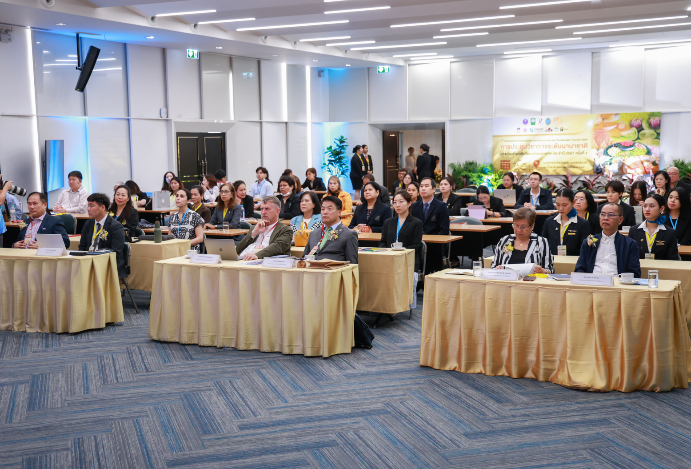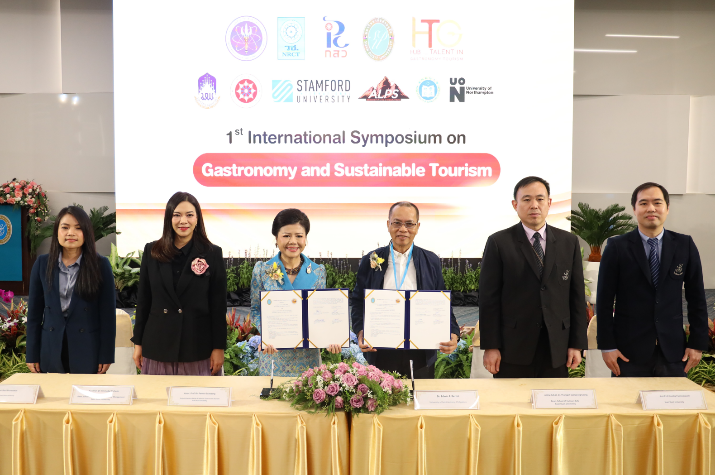Suan Dusit University is a higher education institution rooted in Thailand’s long-standing tradition of home economics and teacher education, dating back to 1934. The university is located within the historically significant area of Suan Dusit–Suan Sunandha, once part of Dusit Palace built during the reign of King Chulalongkorn (Rama V). This area holds exceptional cultural, architectural, and historical landscape value, distinguishing it from other universities. Suan Dusit University has leveraged this unique heritage as a foundation to transform its historical grounds into public learning spaces, directly aligning with SDG 11: Sustainable Cities and Communities, particularly in the area of cultural heritage preservation and public accessibility.
In 2024, the university continued to uphold the concept “Everywhere is Learning Space – Every area of Suan Dusit University is a learning space.” While this philosophy is often represented through libraries and online learning platforms (SDG 11.2.2), it also extends to physical and cultural dimensions—including exhibition areas, galleries, historical corners, and art and cultural showcases within academic buildings. This means that Suan Dusit University does not limit “open spaces” to libraries alone, but also opens its historically and culturally significant buildings to the public under regulated access guidelines.
In 2024, the university further strengthened its role as a “University for Community” by providing public access to both tangible heritage (such as heritage buildings and architectural landmarks) and intangible heritage (such as cultural wisdom, arts, and traditions). Through these initiatives, Suan Dusit University bridges the past, present, and future of Thai society—connecting people through arts, culture, and traditional knowledge.
1. Museum of Architecture and Historical Buildings
The Suan Dusit University campus in Bangkok is located within the grounds of Suan Sunandha Palace, which forms part of the Dusit Palace complex commissioned by King Chulalongkorn (Rama V) in 1899. Several structures on the campus hold significant historical and architectural value, including:
- The ancient wall near Gate 4, constructed from Mon bricks and decorated with stucco motifs of the Phuttan flower, representing exquisite craftsmanship of the period;
- The Yaowapa Building and the Wapi Busabakorn Building, examples of Italian Renaissance–style architecture from the early twentieth century;
- The Suan Sunandha monuments and landscaped gardens, which preserve the original layout of the former royal residence for the ladies of the court.
These heritage sites are not only preserved but are also open to the public, students, and visitors for educational and cultural purposes. Access is granted on various occasions, such as study visits organized by the Ministry of Higher Education, Science, Research and Innovation, and official visits from international delegations, including the Ministry of Higher Education and Culture of Timor-Leste (MHESC). Together, these historic buildings serve as a “Museum of Thai Educational Architecture”, narrating the legacy of women’s education and the development of home economics in Thai society for over 90 years.
Suan Dusit University humbly expresses its profound gratitude for the royal benevolence of His Majesty King Maha Vajiralongkorn Phra Vajiraklaochaoyuhua (Rama X), who graciously granted a royal audience to Associate Professor Dr. Sirot Pholpanthin, President of Suan Dusit University, to receive the land title deed issued in His Majesty’s name, covering an area of 37 rai, 1 ngan, and 10 square wah.
The royal ceremony took place on Sunday, November 22, 2020, at 6:00 p.m. at Amphorn Sathan Residential Hall. Following this gracious occasion, the university organized a small exhibition on the first floor of the University Administration Building, displaying photographs and information documenting the historic event for staff, students, and visitors to commemorate and appreciate this momentous royal bestowal.




2. Museum of Culture and Wisdom
Alongside its historic buildings, the university also preserves and promotes cultural heritage through various activities and exhibitions, such as:
“Kon Krang Craft” – The 1st Lac-Dye Textile Festival in Lampang (March 30, 2024), which showcased research-based knowledge through an art and textile exhibition, accompanied by free public workshops for community participation.


“Suphanburi Creative City of Music and Food” (September 27, 2024) — a gallery exhibition showcasing youth creativity in local music and culinary arts.



 “1st International Symposium on Gastronomy and Sustainable Tourism” (August 24–25, 2024) — an international academic conference open to the public, featuring exhibitions of Thai cuisine and the art of traditional food presentation. https://www.dusit.ac.th/home/2024/1320853.html
“1st International Symposium on Gastronomy and Sustainable Tourism” (August 24–25, 2024) — an international academic conference open to the public, featuring exhibitions of Thai cuisine and the art of traditional food presentation. https://www.dusit.ac.th/home/2024/1320853.html


“Sarap Khang Wang: The Dusit Culinary Chronicles” (November 5, 2024) — a Thai culinary exhibition showcasing the heritage of home economics and Thai soft power through flavors, food culture, and traditional folk performances.




These activities have transformed the university into a Living Museum, where the public can continuously learn, experience, and participate in arts and culture. The museums of Suan Dusit are therefore not merely “repositories of the past,” but also “learning spaces of the present.” In 2024, more than 1,000 participants, including members of the public and students, took part in the university’s museum and cultural activities. The continuous opening of these spaces has resulted in:
- Preservation and dissemination of historical architecture.
- Promotion of local cultural economies, such as lac-dyed textiles, Thai cuisine, and handicrafts.
- National and international collaboration to advance Thailand’s soft power in arts, gastronomy, and cultural tourism.
- Fostering lifelong learning within the context of a historic urban community.
Suan Dusit University thus stands as a model of an institution that harmoniously integrates “space” and “wisdom,” creating a museum where people not only observe but also participate and take pride in their cultural heritage.
